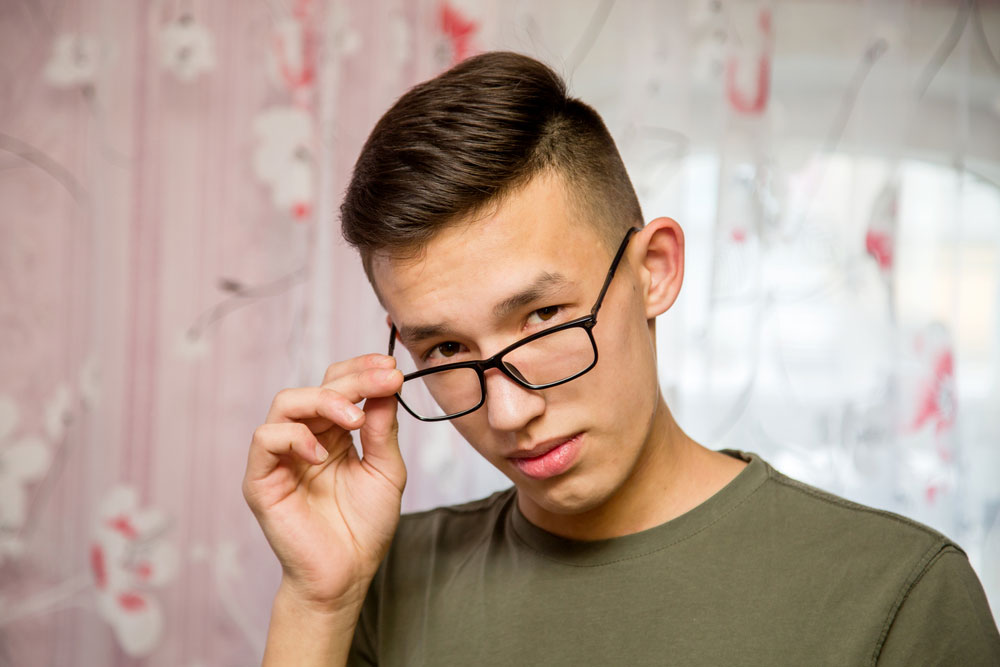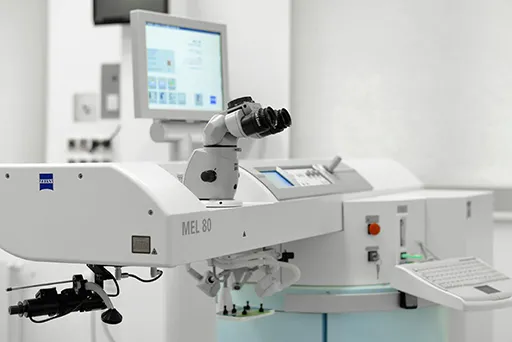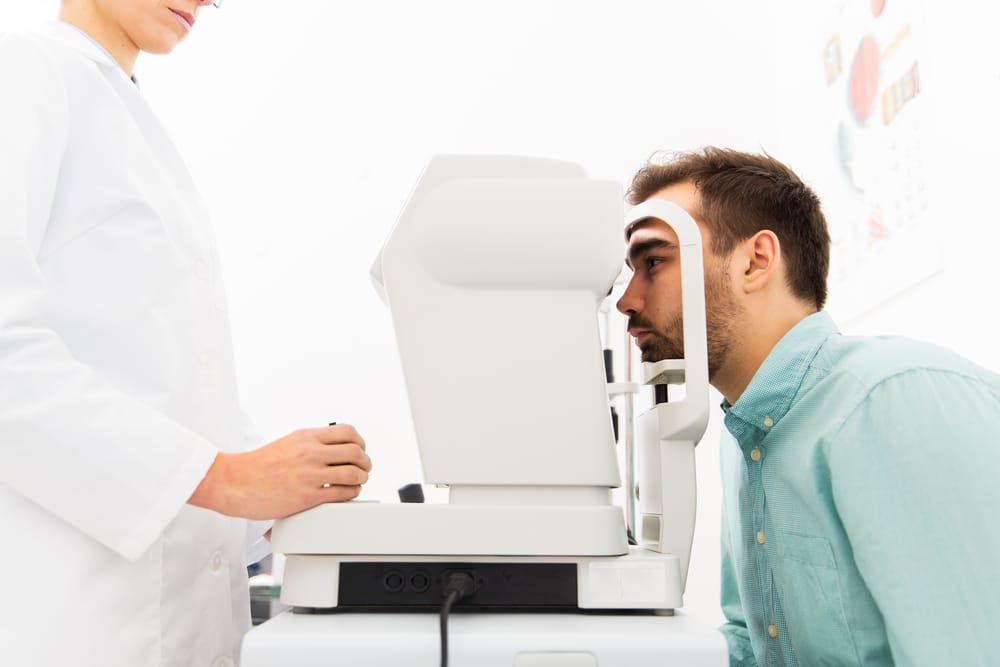Refractive Errors
In a perfectly shaped eye, the cornea (which is the clear front surface of the eye) and the natural crystalline lens (a clear structure inside the eye that changes shape to help with focusing) help you to see sharp images. However, if the cornea or lens are not correctly matched or if the eye is not perfectly shaped, light rays will not be bent properly and refractive errors will occur. Common refractive errors include Myopia, Hyperopia, Astigmatism, and Presbyopia.
Myopia (Short-sightedness or Near-sightedness)
Myopia is a refractive condition due to either the eyeball being too long or the cornea being too curved, resulting in the image focusing just in front of the retina. In such cases, distant objects are not seen clearly.
Myopia is the most common refractive error in Singapore affecting around 80% of the population. The prevalence of myopia in Singapore is one of the highest in the world, affecting around 20% of children aged 7 and 80% of boys by the time they enter National Service.
Hyperopia (Long-sightedness or Far-sightedness)
Hyperopia is a refractive condition due to either the eyeball being too short or the cornea being too flat, resulting in the image focusing just behind the retina. In such cases, near objects are not seen clearly.
Astigmatism (“San Guang”)
Astigmatism is a result of the cornea being more steeply curved in one direction. This causes the image to be distorted when it is focused on the retina. It can occur with either myopia or hyperopia and results in the blurring of both distant and near objects.


Myopia (Short-sightedness or Near-sightedness)
Myopia is a refractive condition due to either the eyeball being too long or the cornea being too curved, resulting in the image focusing just in front of the retina. In such cases, distant objects are not seen clearly.
Myopia is the most common refractive error in Singapore affecting around 80% of the population. The prevalence of myopia in Singapore is one of the highest in the world, affecting around 20% of children aged 7 and 80% of boys by the time they enter National Service.

Hyperopia (Long-sightedness or Far-sightedness)
Hyperopia is a refractive condition due to either the eyeball being too short or the cornea being too flat, resulting in the image focusing just behind the retina. In such cases, near objects are not seen clearly.
Astigmatism (“San Guang”)
Astigmatism is a result of the cornea being more steeply curved in one direction. This causes the image to be distorted when it is focused on the retina. It can occur with either myopia or hyperopia and results in the blurring of both distant and near objects.

What are the treatment options for Vision Correction?
Prescriptive Spectacles
Spectacles are a common method of vision correction. They are convenient, safe and affordable. However, wearing spectacles may cause some inconveniences:
- Spectacles may not be suitable for certain occupations like firemen and athletes, or for those with active sporting lifestyles like scuba diving, martial arts etc.
- Spectacles may fog up in humid climates and can be uncomfortable to wear or appear less attractive.
- Spectacles can be broken or lost.
Contact Lens
Contact lens may be a good alternative to glasses. Since they are ‘invisible’, they are thought to be more aesthetically pleasing. There are various types of contact lenses available in the market- soft, hard, ortho-k lenses. The choice usually depends on the health of the eye and the preference of the patient. These contact lenses may be permanent lenses or disposable lenses.
Disposable lenses come in either daily, fortnightly or monthly wear alternatives. Disposable lenses should not be used beyond the recommended period and have to be discarded accordingly. Hard lenses or rigid gas permeable lenses allow better oxygen transmission and may be associated with less allergic response as compared to soft lenses, but are much more uncomfortable to wear.
Contact lenses are generally safe if the person does not overuse the lenses and maintains strict hygiene measures. However, there are possible complications of contact lenses, some of which leading to blindness, particularly if there is a compromise in lens care and hygiene.
The side effects of contact lens use include:
- Corneal infections
- Corneal oedema (swelling) or the growth of new blood vessels (neovascularization) as a result of reduced oxygen delivery
- Corneal abrasions
- Allergic conjunctivitis (Giant papillary conjunctivitis)
- Ptosis (droopy eyelids due to the prolonged stretching of the eyelids)
Contact lens may not be a good choice if you:
- Are not able to maintain a meticulous hygiene routine
- Work for more than 8 hours at a stretch and find it inconvenient to remove them at work
- Have dry eyes or ocular surface problems
- Are prone to recurrent corneal infections
- Work in a dry or dusty environment
- Participate in water sports
Laser Vision Correction
- LASIK (Laser-Assisted in Situ Keratomileusis)
- Advanced Surface Ablation procedures
- PRK (Photorefractive Keratectomy)
- LASEK (Laser Epithelial Keratomileusis)
- Epi-LASIK (Epithelial Laser in Situ Keratomileusis)
- ZEISS SMILE® Pro (Small Incision Lenticule Extraction)
- ICL (Implantable Collamer Lens)
All refractive eye surgical procedures aim to reduce the dependency on spectacles and contact lens to improve quality of life, especially for those with higher corrections.
Presbyopia (“Lao Hua”)
Presbyopia, also known as “lao hua” usually develops as part of the normal aging process which tends to present from 40 years old onwards. The eye loses the ability to accommodate and focus on near objects. A person with presbyopia will begin to experience blurred near vision when reading, sewing or working at the computer. It becomes worse with dim lighting, but distance vision is usually unaffected.
Presbyopia generally stems from a gradual thickening and loss of flexibility of the natural lens due to the build-up of protein in the lens. This build-up causes the lens to harden and become less elastic over time. As one ages, the fibres of the surrounding eye muscles also start to weaken. This weakness and loss of flexibility of the eye muscles make it more difficult for the eye to focus on near objects.

What are the treatment options for Presbyopia?
Prescriptive Spectacles or Contact Lens
Presbyopia can be corrected with prescriptive glasses or contact lens with bifocal or multifocal correction. These progressive lenses will allow you to see far and near distances, especially if you have existing refractive errors like myopia and astigmatism.
Monovision LASIK
Monovision LASIK is another treatment option for presbyopia. Monovision LASIK corrects the distance vision in the dominant eye and corrects the near vision in the non-dominant eye. This allows a person with presbyopia to see distance and near vision at the same time without any vision aids or reading glasses. Read more about monovision LASIK.
There are several options for managing presbyopia and the ideal treatment for the individual is customisable.




